
Google's self-driving car could come with external airbags to protect pedestrians, according to a patent filing made by the search giant.
A pod-like autonomous car with no conventional controls has been in development at Google's California headquarters for several years, but now the patent filing takes Google's attention beyond self-driving and into car safety.
Awarded on 24 March, the patent outlines a system where external airbags integrated into a car's bumpers deploy outwards when the car detects an unavoidable collision with a pedestrian or other vehicles. As is usually the case with patent filings, few specific details are given but Google describes the material used as "visco-elastic."
This is thought to be similar to the material of ear plugs and memory foam, which would absorb an impact but not bounce back and risk pushing the pedestrian back into the road. Although its self-driving cars are believed to have had just two incidents during thousands of miles of testing and development, Google has an uphill struggle on its hands to convince drivers that autonomous cars are safe.
A study conducted in early 2015 found almost half of British adults would not be happy to be a passenger in a self-driving car, with the majority of these refusing because of concerns over the safety of other drivers. More than 40% of those asked said they would not trust a car to drive safely without a driver and 16% said they were "horrified" by the autonomous concepts being pushed by car companies.
A worry over insurance implications is shared by 35% of the population, who expect the introduction of self-driving cars to increase their premiums; a quarter believe any accidents involving autonomous cars should be blamed on the manufacturer, rather than themselves or other road users. Almost one-in-five would hold the driver responsible, no matter if the car was controlling itself in an autonomous drive mode or not.
Google is not the first company to develop external airbags. Volvo already has pedestrian-sensing airbags on some of its cars, but they don't include the memory foam-like material mentioned by Google.






Comment